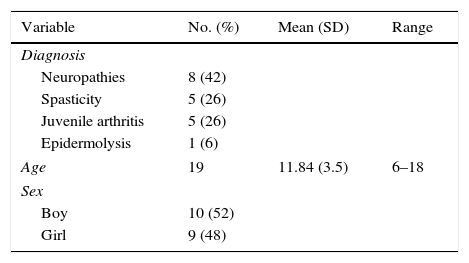Parental report on a child's secondary chronic pain is commonly requested by anesthesiologists when the child cannot directly provide information. Daily pain intensity is reported as highest, average and lowest. However, it is unclear whether the parents’ score is a valid indicator of the child's pain experience.
MethodsNineteen children (aged 6–18years) with secondary chronic pain attending our anesthesiologist-run pediatric pain unit participated in this study. Identification of highest, average and lowest pain intensity levels were requested during initial screening interviews with the child and parents. Pain intensity was scored on a 0–10 numerical rating scale. Agreement was examined using: (i) intraclass correlation coefficient (ICC), and (ii) the Bland–Altman method.
ResultsThe ICC's between the children and the parents’ pain intensity reports were: 0.92 for the highest, 0.68 for the average, and 0.50 for the lowest pain intensity domains. The limits of agreement set at 95% between child and parental reports were respectively +2.19 to −2.07, +3.17 to −3.88 and +5.15 to −5.50 for the highest, average and lowest pain domains.
ConclusionsFor the highest pain intensity domain, agreement between parents and children was excellent. If replicated this preliminary finding would suggest the highest pain intensity is the easiest domain for reporting pain intensity when a child cannot directly express him or herself.
Habitualmente los anestesiólogos solicitan a los progenitores la información acerca del dolor crónico secundario pediátrico (cuando los propios pacientes no son capaces de hacerlo) incluyendo 3 valores: máximo, medio y mínimo. Se desconoce cuál de estos 3 refleja de un modo más fiable el estado de dolor.
MétodosDiecinueve niñas/os (6-18 años) con dolor crónico secundario tratados en la unidad de dolor infantil fueron incluidos en el estudio. El dolor crónico máximo, medio y mínimo fueron reportados por los padres y por los pacientes al inicio de su tratamiento usando la escala numérica del dolor del 0 al 10. La correlación entre padres e hijos se realizó con el coeficiente de intraclase (CIC) y el método de Bland-Altman.
ResultadosLos límites de concordancia (al 95%) entre padres e hijos oscilaron entre +2,19 y −2,07, entre +3,17 y −3,88 y entre +5,15 y −5,50, y los CIC fueron de 0,92, de 0,68 y de 0,50 para el dolor máximo, medio y mínimo, respectivamente.
ConclusionesSolo los valores del dolor máximo mostraron una concordancia excelente entre padres e hijos. Estos resultados, aunque preliminares, parecen indicar que básicamente el dolor crónico máximo pediátrico podría ser interpretado de un modo más fidedigno por los padres de los pacientes que son incapaces de expresarse verbalmente.










